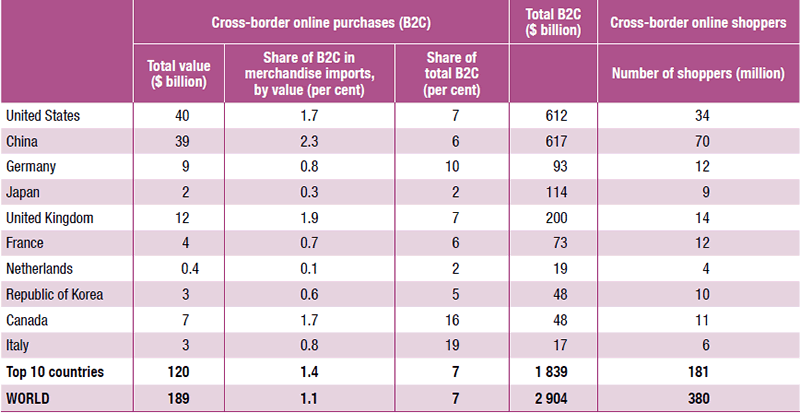Digitalization is impacting every aspect of production and trade, from the largest corporations to the smallest traders, but there is a risk that it will lead to widening income inequalities, UNCTAD said today in its Information Economy Report 2017: Digitalization, Trade and Development.
Information and communications technologies (ICTs), electronic commerce (e-commerce) and other digital applications are helping a growing number of small businesses and entrepreneurs in developing countries to connect with global markets and open up new ways of generating income. They are being leveraged to promote business, including the empowerment of women as entrepreneurs and traders, and to support productive activities.
The digital economy is expanding fast in the global South. Developing economies, led by China and India, accounted for nearly 90 per cent of the 750 million people that went online for the first time between 2012 and 2015 according to data from the International Telecommunication Union.
“We at UNCTAD are excited by the transformational power of digitalization, but we must recognize that the Internet is not a panacea,” UNCTAD Secretary-General Mukhisa Kituyi said.
“Effective national and international policies are needed to make sure the gains are spread evenly across as well as within countries,” Dr. Kituyi added.
The report points out that more than half of the world’s population remains offline, and the pace of growth in access and use is slowing. Specifically, in the world’s least developed countries only one in six people used the Internet in 2016.
Globally, the digitalization of economic activities has been fast-tracked thanks to expanding access to high-speed broadband and the drastic reduction of cost for ICT equipment and software. The average cost of 1 gigabyte of hard drive storage capacity, for example, fell from more than US$400,000 in 1980 to US$0.02 in 2016.
Digitalization is fuelling the rise of 3D printing, artificial intelligence, the Internet of things, cloud computing, big data and automation, including in developing countries. In Myanmar, for instance, farmers use a 3D printer to create parts for a sprinkler system and the internal mechanics for a solar pump. In the United Republic of Tanzania, recycled plastic bottles are being used as the raw material for 3D-print prosthetics.
Productivity gains from digitalization, however, may accrue mainly to a few, already wealthy and skilled individuals. Winner-takes-all dynamics are typical in Internet platform-based economies, where network effects benefit first movers and standard setters. The world’s top four companies by market capitalization are all closely linked to the digital economy: Apple, Alphabet (Google), Microsoft and Amazon.
The UNCTAD research released today comes amid rising concerns over widening income inequality. In countries of the Organization for Economic Cooperation and Development, where the digital economy has evolved the most, growing use of ICTs has been accompanied by an increasing income gap between the rich and poor.
Recommendations from UNCTAD experts include a call for countries to ensure an adequate supply of skilled workers with strong adaptive and creative skills necessary for “working with the machines”. More blue- as well as white-collar jobs may become obsolete due to automation.
“All countries will need to adjust their education and training systems to deliver the skills required in the digital economy,” the report says.
With more trade going digital, and with data flows playing a more important role for companies, closer dialogue will be needed between the trade and Internet policy communities. Data flows and the Internet of things, for instance, raise concerns related to data privacy and security.
The policy challenge depends on countries’ readiness to engage in and benefit from the digital economy, with the least developed countries the least prepared. To ensure that more people and enterprises in developing countries have the capacity to participate effectively, the international community will need to expand its support. International support and collaboration on a massive scale are needed to prevent the evolving digital economy from widening the digital divides and existing income inequalities.
KEY FACTS ABOUT THE DIGITAL ECONOMY
Growth:
By 2019, global Internet traffic is expected to be 66 times higher than in 2005
Production of ICT goods and services accounts for some 6.5 per cent of global GDP
Some 100 million people are now employed in the ICT services sector
Exports of ICT services grew by 40 per cent between 2010 and 2015
Shipments of 3D printers are expected to grow from 450,000 in 2016 to 6.7 million in 2020, a fifteen-fold increase in just three years
Development challenges:
With an estimated 16 per cent of individuals in the least developed countries using the Internet in 2016, the target of universal access to the Internet for these countries set in the Sustainable Development Goals is far off
Urban–rural divide: 3G networks cover 89 per cent of urban areas, but only 29 per cent of rural areas; the gap is the most pronounced in low-income countries
The Internet gender divide is most pronounced in developing countries
E-commerce use in the least developed countries is typically below 2 per cent of population, compared with more than 50 per cent in many developed countries
Only 4 per cent of the world’s 3D printers are used in Africa and Latin America
In Africa, less than 40 per cent of countries have adopted data privacy legislation, and in Oceania, only the Cook Islands has such legislation


Abbreviation: B2C, business to consumer



